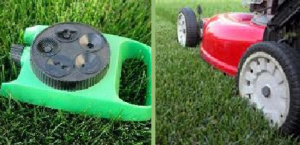Watering and Mowing Lawn Care Practices for a Healthy Green Lawn
 Good cultural watering and mowing practices are critical to keeping your lawn healthy and stress-free. A healthy lawn not only looks nice, it also acts as a natural air purifier by removing carbon dioxide from the air. A healthy lawn can even provide a cooling barrier around the house — check out the remarkable difference in temperature by feeling the difference between the surrounding concrete or asphalt and the lawn with your hand.
Good cultural watering and mowing practices are critical to keeping your lawn healthy and stress-free. A healthy lawn not only looks nice, it also acts as a natural air purifier by removing carbon dioxide from the air. A healthy lawn can even provide a cooling barrier around the house — check out the remarkable difference in temperature by feeling the difference between the surrounding concrete or asphalt and the lawn with your hand.
Watering
It’s a fact: the hotter it gets, the more water your lawn needs. How much water is enough? Generally, during the hottest months, watering every other day (three to four times a week) is sufficient. Water for 30 minutes with fixed sprinklers or 45 minutes with rotating sprinklers. Watering deeply, rather than frequent shallow watering, encourages stronger, deeper root growth.
Early morning (before sunrise) is the best time of day to water. Daytime watering uses more water due to heat and evaporation. Nighttime watering leaves grass blades wet for an extended period of time and tends to promote lawn fungus problems. It’s okay to begin watering as early as 2 a.m. if that’s the amount of time needed to complete your watering cycle by sunrise. However, watering at anytime is better than allowing lawn to become dry. In other words, don’t put off watering a dry lawn because of the hour of the day.
The best way to test if your lawn is getting enough water is to set out soup cans (tuna cans are too shallow) and test. Time how long it takes for a half-inch to 1-inch of water to collect. That’s the amount needed to moisten most soils to an ideal depth of 5 to 7 inches. Be sure your sprinkler heads are aimed at your lawn, rather than the street or sidewalk.
While it’s typical for grass to be greener in shady areas of yard, that’s also an indicator that your lawn needs more water overall. Brown spots aren’t always an indicator that more water is needed, however they may be signs of billbug grub larvae. A healthy, well-fertilized lawn will recover better from grub and drought problems. Many lawns typically have one or two small problem areas that require a little more water than they’re getting. If this is the case with your lawn, get out the trusty watering can and water the area by hand.
Mowing
Once you’ve got your best watering practices down, how do you keep that lush, green grass looking manicured? First things first: keep your mower blade sharp. A dull blade results in ragged tips that turn grass blades a straw color. Adjust your mower blade height from 2.5 inches to 3 inches as the temperature goes up during the summer season (3 inches is ideal during periods of drought stress). Mowing high improves lawn quality and water retention. Mow frequently so you’re only cutting about 1/3-inch in a single mowing. Alternate your mowing pattern to improve lawn health and appearance.
Green Pointe Lawn Care wants your lawn to look green and healthy. Read more tips for best watering and mowing practices, or contact us today for a free lawn care quote!
 Green Pointe Lawn Care
Green Pointe Lawn Care